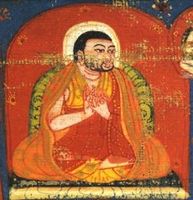Pakmodrupa Dorje Gyalpo
Phag mo gru pa rdo rje rgyal po
| PersonType | Category:Classical Tibetan Authors |
|---|---|
| MainNamePhon | Pakmodrupa Dorje Gyalpo |
| MainNameTib | ཕག་མོ་གྲུ་པ་རྡོ་རྗེ་རྒྱལ་པོ་ |
| MainNameWylie | phag mo gru pa rdo rje rgyal po |
| AltNamesTib | ཕག་མོ་གྲུ་པ་ |
| AltNamesWylie | phag mo gru pa |
| BiographicalInfo | He was the older brother or cousin of KaH thog dam pa bde gshegs. |
| YearBirth | 1110 |
| YearDeath | 1170 |
| TibDateGender | Male |
| TibDateElement | Iron |
| TibDateAnimal | Tiger |
| TibDateRabjung | 2 |
| ReligiousAffiliation | phag gru bka' brgyud |
| StudentOf | Sachen Kunga Nyingpo · Gampopa · Chapa Chökyi Senge |
| TeacherOf | Jikten Gönpo · gling ras pa pad+ma rdo rje · stag lung thang pa bkra shis dpal · gyer sgom tshul khrims seng+ge · Tropu Lotsāwa Jampai Pal · Drogon Rechen |
| BDRC | https://www.tbrc.org/#!rid=P127 |
| Treasury of Lives | https://treasuryoflives.org/biographies/view/Pakmodrupa-Dorje-Gyelpo/2539 |
| Himalayan Art Resources | https://www.himalayanart.org/search/set.cfm?setID=956 |
| IsInGyatsa | No |
| BnwShortPersonBio | A Tibetan scholar and adept who is counted as one of the great disciples of the key Bka’ brgyud founder Sgam po pa Bsod nams rinchen, and is venerated as the source for many subsequent Bka’ brgyud lineages. Born in the ’Bri lung rme shod region of eastern Tibet, Phag mo gru pa’s parents died while he was still young. Receiving ordination as a novice Buddhist monk at the age of eight, he studied under a variety of teachers during the early part of his life. At eighteen, he traveled to central Tibet, receiving full ordination at the age of twenty-five. There he trained under a number of Bka’ gdams pa teachers, and later, under the great Sa skya master Sa chen Kun dga snying po, from whom he received extensive instruction in the tradition of the path and its result (lam ’bras). At the age of forty, he traveled to Dwags lha sgam po in Southern Tibet, where he met Sgam po pa, who became his principal guru. Sgam po pa famously held up a half-eaten ball of parched barley flour mixed with tea and said to Phag mo gru pa, “This is greater than the results of all your previous meditation.” After he demonstrated his humility by carrying stones to build a stūpa, Sgam po pa gave Phag mo gru pa the transmission of instructions on mahāmudrā meditation and, through their practice, is said to have attained great realization. In 1158, Phag mo gru pa established a simple meditation hut where he lived until his death in 1170; this location later served as the foundation for the influential monastery of Gdan sa mthil. Phag mo gru pa was renowned for his strict adherence to the vinaya, even going on alms rounds, a rare practice in Tibet. Several individuals among his many followers established a number of important branch lineages, the so-called “eight minor Bka’ brgyud subsects” that collectively came to be known as the Phag gru Bka’ brgyud. (Robert E. Buswell Jr. and Donald S. Lopez Jr. The Princeton Dictionary of Buddhism [Princeton, NJ: Princeton University Press, 2014], 639). |
| PosEmptyLumin | Tathagatagarbha as the Dharmakaya |
| PosEmptyLuminNotes |
|
| Other wikis |
If the page does not yet exist on the remote wiki, you can paste the tag |
"Tathagatagarbha as the Dharmakaya" is not in the list (Tathāgatagarbha as the Emptiness That is a Non-implicative Negation (without enlightened qualities), Tathāgatagarbha as the Emptiness That is an Implicative Negation (with enlightened qualities), Tathāgatagarbha as Mind's Luminous Nature, Tathāgatagarbha as the Unity of Emptiness and Luminosity, Tathāgatagarbha as a Causal Potential or Disposition (gotra), Tathāgatagarbha as the Resultant State of Buddhahood, Tathāgatagarbha as the Latent State of Buddhahood that is Obscured in Sentient Beings, There are several types of Tathāgatagarbha, Tathāgatagarbha was Taught Merely to Encourage Sentient Beings to Enter the Path) of allowed values for the "PosEmptyLumin" property.

